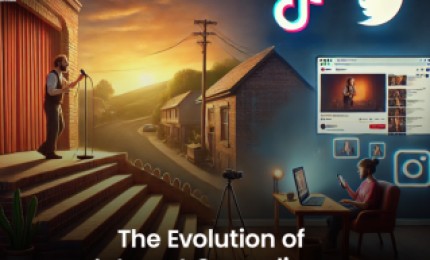The entertainment industry has been profoundly impacted by technological advancements. With a decade of experience in digital marketing, I've observed how technology has both revolutionized and complicated the landscape for creatives. This article aims to dissect the intricate relationship between technology and entertainment, focusing on the opportunities and challenges that have emerged for creatives in this digital era. The objective is to offer a comprehensive guide that can help industry professionals navigate this complex landscape, all while driving more leads and traffic to their digital platforms.
The digital age has democratized content creation to an unprecedented extent. Now, anyone with a smartphone and an internet connection can produce and publish content, effectively becoming a one-person media company. This democratization has led to a surge in user-generated content, flooding platforms like YouTube, Instagram, and TikTok. While this has created incredible opportunities for undiscovered talent to showcase their skills, it has also led to an oversaturated market. The challenge for creatives is not just to produce high-quality content but to effectively market it in a crowded digital landscape. This involves leveraging social media algorithms, understanding SEO, and building a dedicated audience through consistent and engaging content.
Streaming services have fundamentally altered the way we consume entertainment. Gone are the days of waiting for a specific time to watch a TV show or going to a store to buy a music album. Platforms like Netflix, Spotify, and Hulu have made entertainment accessible at the click of a button. However, this convenience comes at a cost for creatives. Traditional revenue models, particularly for musicians and filmmakers, have been disrupted. Instead of a one-time purchase, artists now often earn money through microtransactions, receiving a small amount each time their work is streamed. This model can offer broader exposure but often results in lower upfront payments, requiring creatives to adapt their revenue strategies.
Social media has become an indispensable tool for creatives, offering a direct line of communication to their audience. Platforms like Instagram and Twitter allow artists to bypass traditional gatekeepers such as publishers and record labels, giving them unprecedented control over their work. However, this freedom comes with its own set of challenges. The algorithmic nature of these platforms often prioritizes engagement over quality, forcing artists to produce content that is more 'shareable' than meaningful. Additionally, the constant demand for new content can lead to creative burnout, affecting both the quality and quantity of the work produced.
Virtual Reality (VR) and Augmented Reality (AR) represent the next frontier in entertainment, offering immersive experiences that were previously unimaginable. These technologies have the potential to revolutionize storytelling, gaming, and even social interaction. However, the adoption of VR and AR comes with its own set of challenges. The cost of production can be prohibitively high, and the technology itself is still in its nascent stages, requiring specialized skills that many creatives may not possess. Despite these hurdles, those who can successfully navigate this complex landscape stand to gain a significant first-mover advantage, opening up entirely new avenues for creative expression.
Artificial Intelligence (AI) is increasingly playing a role in the creative process. Machine learning algorithms can assist in scriptwriting, music composition, and even visual design. While this can significantly speed up the creative process and offer new tools for artistic expression, it also raises ethical and existential questions. The most pressing concern is the potential for AI to replace human creatives, reducing the need for human ingenuity and originality. Therefore, the challenge for creatives is to find ways to integrate AI into their work in a manner that enhances rather than replaces human creativity.
In today's digital age, data analytics have become a powerful tool for creatives. Analytics can provide deep insights into audience behavior, preferences, and engagement, offering a roadmap for more targeted and effective content. However, this data-driven approach comes with its own set of challenges. There's a risk of reducing the creative process to a series of algorithms, prioritizing what is popular or trending over genuine artistic expression. The challenge, therefore, is to strike a delicate balance between using data to inform creative decisions while still maintaining one's unique artistic voice.
The digital age has made it easier than ever to distribute content but has also exponentially increased the risks of copyright infringement. Piracy and unauthorized sharing can significantly impact an artist's revenue and intellectual property rights. Despite various legal frameworks in place, enforcing copyright in the digital landscape remains a significant challenge. Creatives must be vigilant in protecting their work, often requiring a proactive approach that includes regular monitoring of how and where their content is being used online.
The rise of the gig economy has had a profound impact on the creative industry. Freelance platforms like Fiverr, Upwork, and Freelancer have democratized access to gigs, making it easier for creatives to find work. However, these platforms also drive down prices due to the global nature of the marketplace. Creatives are now competing on a global scale, often leading to a race to the bottom in terms of pricing. The challenge is to differentiate oneself in this crowded marketplace, offering unique skills or specialized services that can command higher rates.
The digital age has brought both opportunities and challenges for creatives in the entertainment industry. While technology has democratized content creation and opened up new avenues for artistic expression, it has also disrupted traditional revenue models and introduced new complexities around issues like copyright and data analytics. For creatives, the key to success in this ever-evolving landscape lies in their ability to adapt and innovate, without losing sight of their artistic integrity.

15 Ways to Make Money as a Singer: A Complete Guide to Monetizing Your VoiceEarning money as a singer requires more than just talent, it demands creativity, persistence, and a willingness to explore...
Read Blog
When Kunal Kamra's Humor Got Him Into Trouble: A Deep Dive into the Controversies of India's Most Fearless ComedianKunal Kamra Controversy: Laughter, Lawsuits, and the Limits of Free SpeechStand-up...
Read Blog
The Oscar race is always full of drama, but this year? It’s absolute chaos. From shocking controversies to unexpected winners, the battle for Best Picture at the 2024 Academy Awards has taken...
Read Blog
In the ever-changing landscape of entertainment, few transformations have been as dramatic and swift as the rise of internet comedians. What began as a platform for amateur funny videos has evolved...
Read Blog
Introduction: In the competitive world of entertainment and talent, having the right representation can make all the difference in launching and sustaining a successful career. Whether you're...
Read Blog.jpg)
While the world of modelling often dazzles with glitz and glam, it's also critical we discuss its darker shades, pulling the curtain back on some challenging realities. Today, let's embark on...
Read Blog